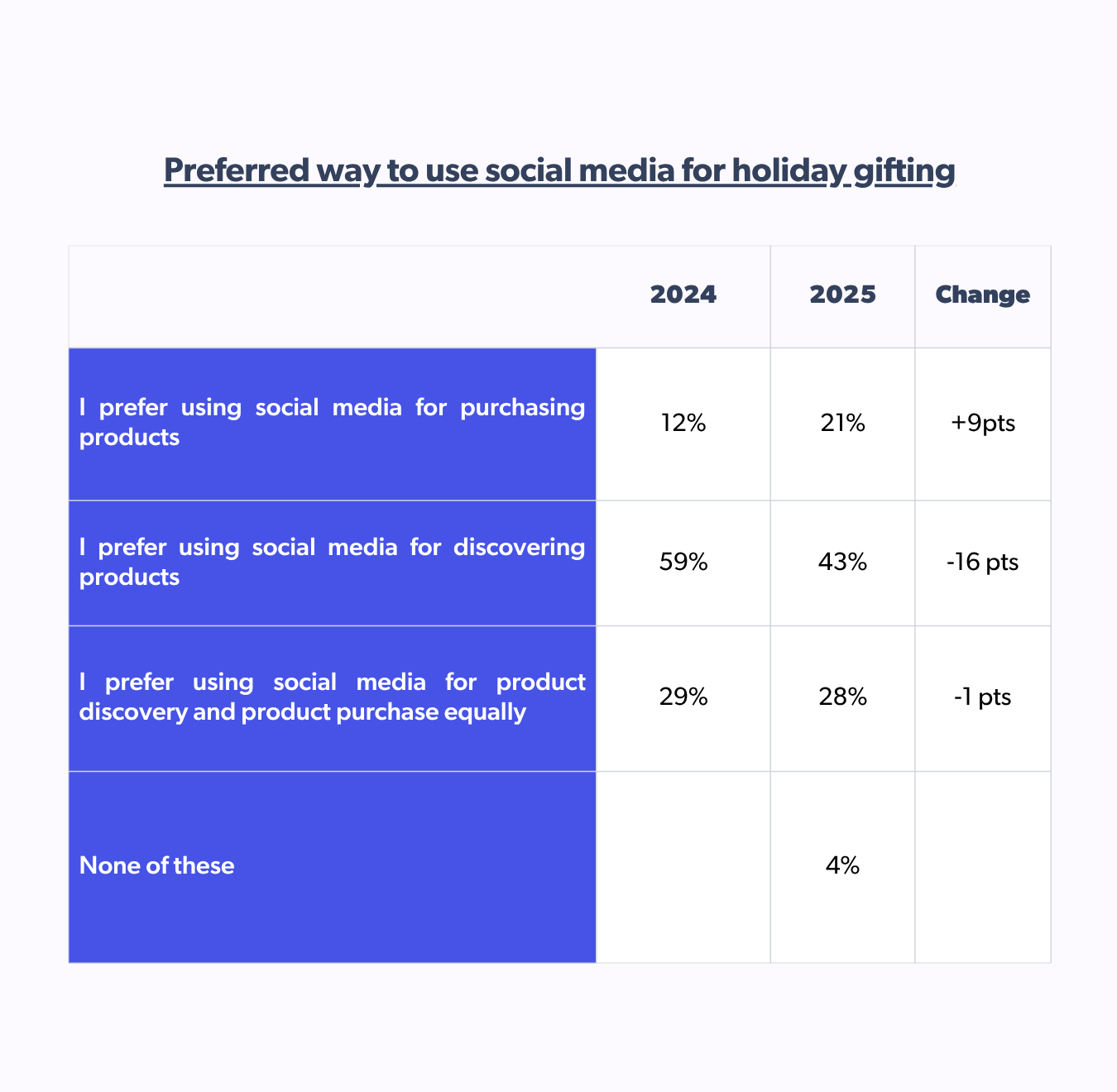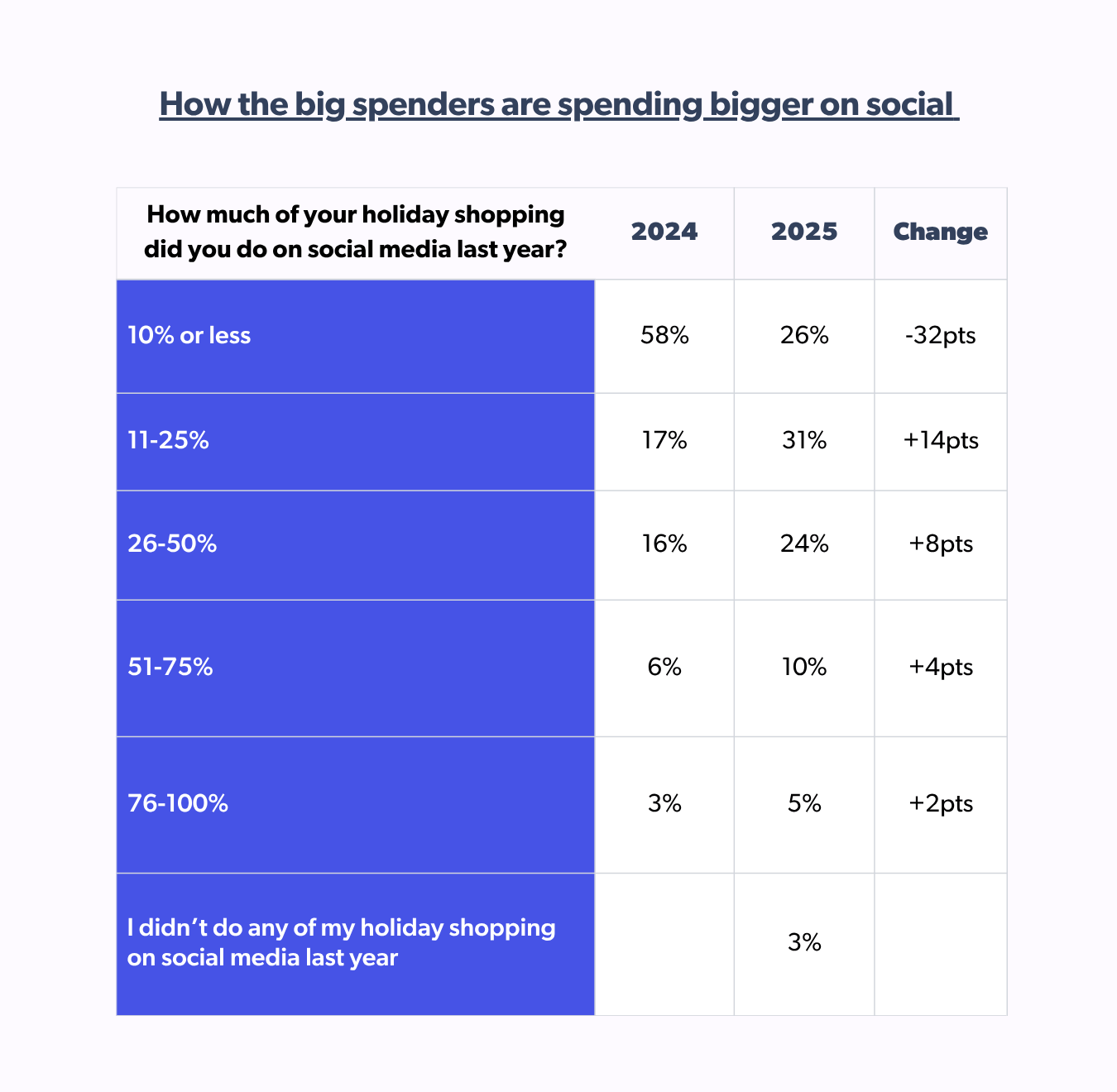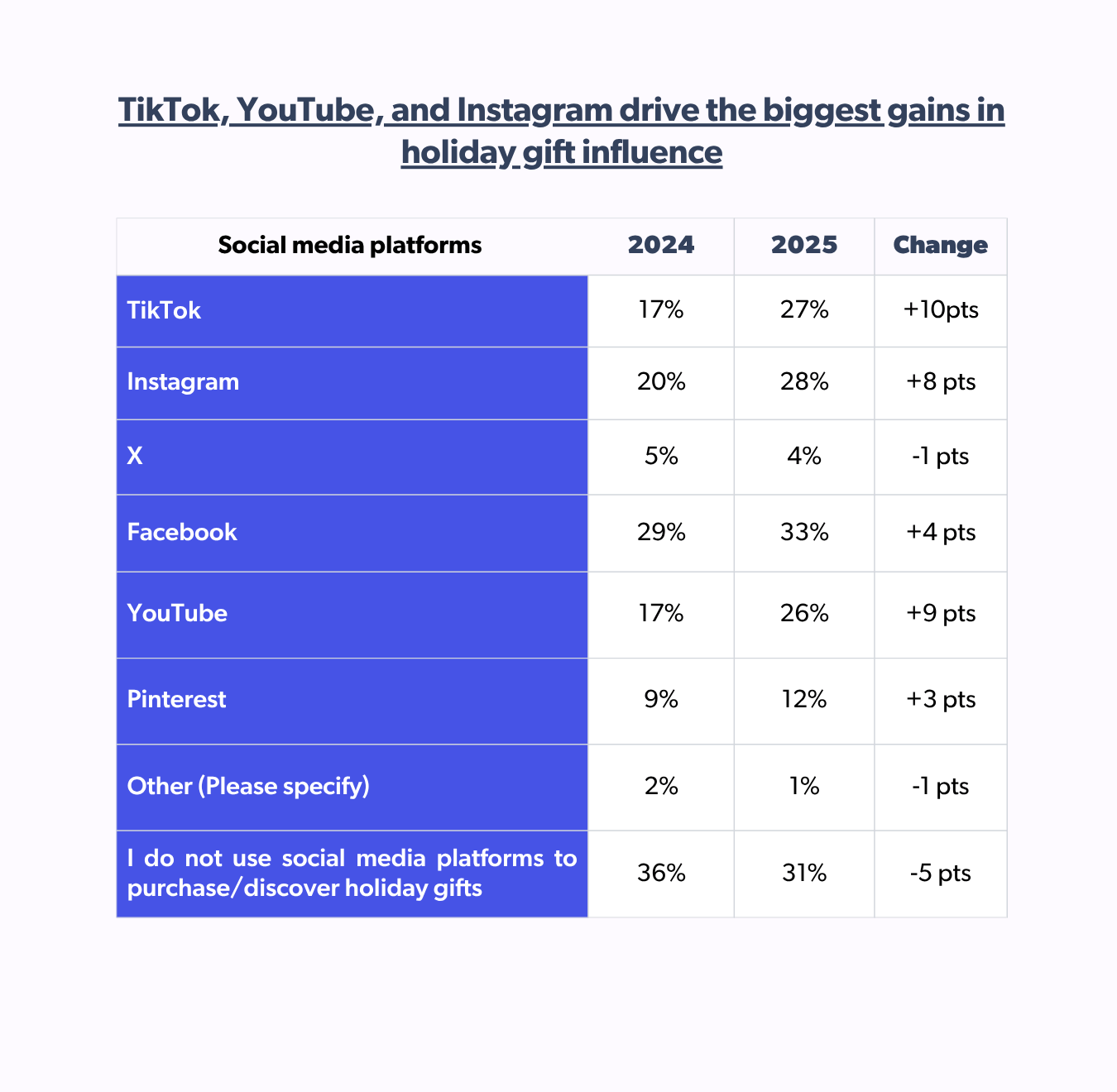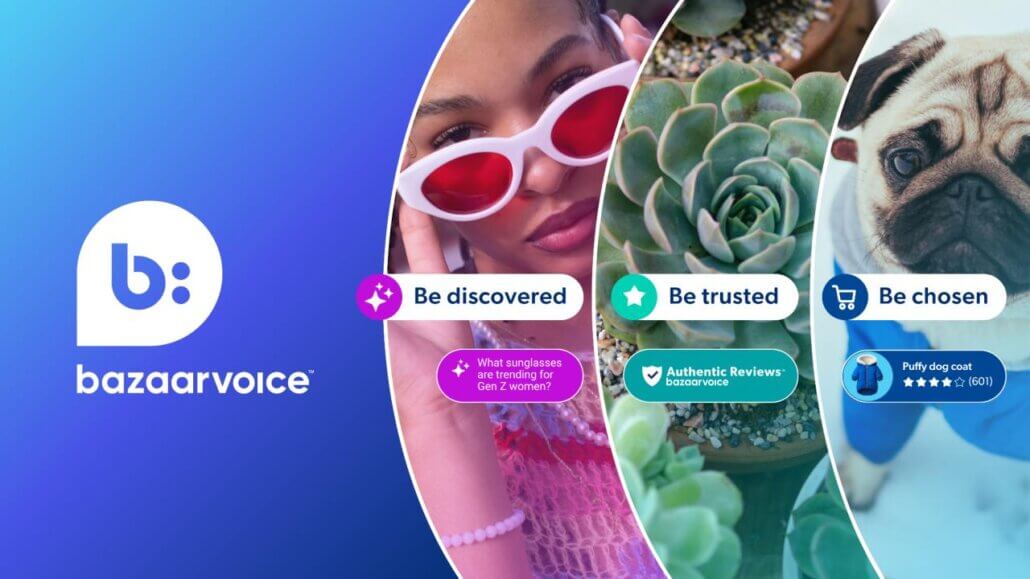June 18, 2025
The way consumers approach holiday shopping on social media has fundamentally changed. But for many brands and retailers, keeping up and effectively turning inspiration into immediate purchase hasn’t been easy.
Fragmented content strategies, difficulty sourcing consistent creator content, and the lack of seamless paths to purchase often leave brands falling short of converting engagement into revenue. Add to that the pressure of holiday timelines, and it’s no wonder many marketing teams feel stretched thin.
Remember the days when social platforms were just for product discovery? Well, those days are gone. Social media is now a destination where holiday wish lists are made and fulfilled.
With a sharp increase in shoppers doing up to 50% of their shopping on social media, social commerce directly leads to conversion.
If your brand isn’t already harnessing the full potential of social commerce, you’re not just missing out on visibility, you’re leaving real revenue on the table.
In this blog, we dive into what our consumer research reveals about the rising share of holiday spending captured by social platforms.
We have also included plenty of great examples for inspiration on creating amazing shoppable experiences on socials this holiday season.
1. More reaching for the ‘Link in bio’ among shoppers of all age
The journey from “Ooh, love this!” to “Oops, I bought it” is now dangerously short. We are talking collapsed funnels where consumers go from discovery to purchase in a matter of seconds and in non-traditional ways.
Consumers don’t just window shop on social media anymore. They’re smashing that ‘buy now’ button ever so often now. We’ve seen a 9-point jump in holiday spending, with folks who prefer to whip out their wallets on social platforms soaring from 12% in 2024 to 21% in 2025.

Social platforms have clearly been playing the steady game and are expertly turning their ‘looky-loo’ advantage into ‘ka-ching!’ channels.
2. Increased and bigger shopper wallets on socials
Social commerce has elbowed its way to the ‘it’ table at the holiday spending fair.
The number of holiday shoppers dedicating a quarter or more of their budget to social media purchases has practically doubled. We’ve seen a dramatic 32-point nose dive in people spending 10% or less of their holiday cash on social media, plummeting from 58% in 2024 to 26% in 2025.
So where’d that money go? Upstairs! Spending in the 11-25% bracket shot by 14 points, and the 26-50% slice of the pie grew by 8 points.

Example: How Home Depot tapped into the power of shoppable content last holiday season
The festive series Merry & Bright, hosted by singer and former American Idol winner Jordin Sparks, follows three families as they transform their homes using Home Depot products, showcasing real-life inspiration for holiday decorating.
To make the experience seamless and instantly shoppable, the content features integrated QR codes that lead viewers directly to a “Shop the Look” page on Home Depot’s website, where they can browse and buy the featured items. This interactive approach is helping drive higher consumer engagement and increased holiday spending.
To truly unlock the full potential of social commerce during the holiday shopping season, brands must extend the magic of social beyond the feed and into their own digital storefronts. An integrated solution can enable you to capture this sudden attention on social platforms and create captivating onsite experiences.
By embedding immersive video galleries, showcasing creator content, and building social storefronts, brands can turn passive browsing into active buying, converting views and engagement into real revenue. It’s not just about meeting shoppers where they are, but guiding them effortlessly from inspiration to purchase, all within your own ecosystem.
3. The overindulged social platforms acting as constant companions
When it comes to the Hunger Games of holiday shopping, some platforms are the Katniss Everdeen of social commerce.
At this point, TikTok’s influence over shoppers can well be attributed to digital voodoo, with its influence on gift buying leaping a massive 10 points from 17% to 27% between 2024 and 2025.
Especially among audiences aged between 18 and 34, over half of them (56%) attribute the most influence of TikTok to holiday shopping.
Instagram is right there with it, flexing an 8-point increase to 28%. Not to be outdone, YouTube has seen its persuasive powers grow by 9 points to 26%. And let’s not forget good old Facebook, ever the heavyweight, bumping up its influence by 4 points to a solid 33%.

A clear generational divide defines social media’s shopping influence. TikTok dominates with younger shoppers (18-34) at 56%, followed closely by Instagram at 49%.
Facebook’s influence peaks in the 35-54 age group (42%). This gap is most stark among shoppers aged 55 and over, a majority of whom (53%) report being uninfluenced by any social platform.
Example: Sephora doubling down on the GifTok momentum
On TikTok, the rise of #GiftTok has transformed holiday gifting into an entertaining and engaging experience. Sephora has smartly tapped into this trend by partnering with creators to launch viral content series like Holiday Gift Inspiration, where beauty recommendations are wrapped in relatable storytelling and festive flair.
The result? Gift discovery that feels less like a sales pitch and more like a friend’s trusted advice, driving both engagement and conversions in the lead-up to the holidays.
4. Shift in what shoppers do on socials
So, what exactly are these holiday shoppers doing on social media? Well, in 2025, 43% still said they prefer using it to discover products.
However, that’s a 16-point drop from the previous year, meaning the thrill of the hunt is slightly waning in favor of the kill or, you know, the purchase.
The “I’m here to buy stuff” crowd grew by a significant 9 points, with 21% admitting they prefer social media for the actual transaction.
And then there are the efficient multitaskers: 28% are using social media for both finding and buying their gifts.
Example: How JC Penney is addressing shifts in economic reality to engage shoppers meaningfully on socials
In a direct response to the inflationary environment impacting holiday shopping, JCPenney’s recent campaign strategically repositions the brand to support budget-conscious consumers.
Under the banner “Make Your Holidays Count,” the retailer has honed its focus on working families, emphasizing the need to make dollars stretch further.
This message is clearly articulated in a series of video ads and creator content that leverage JCPenney’s 120-plus years of experience, promising to make each gift special and ensure that “every hard-earned dollar count[s].” By doing so, the campaign directly acknowledges the financial pressures shoppers face in this environment, aligning the brand as a valuable and understanding partner during the holiday season.
5. Donning the role of a savvy new gift guide and more
Over on Instagram, brands like Nordstrom, Coach, and Glossier are making the most of Reels and influencer collaborations to bring holiday gifting to life. By showcasing wishlist-worthy products styled in authentic, everyday settings, these brands are turning aspirational content into actionable inspiration.
Interactive features in Stories, such as polls, quizzes, and ‘This or That’ gift guides, are boosting engagement by inviting consumers into the discovery process. These formats not only help gather insights about gift preferences but also create micro-moments that keep brands at the top of their minds.
And when it comes to conversion, Instagram Shops seal the deal. With direct product tagging in posts and Stories, users can tap, view, and buy without leaving the app. The result is a frictionless path from liking to buying, making Instagram an essential channel for impulse gifting and last-minute holiday shopping.
Big blow-up: Make your social shoppable or prepare to be the forgotten brand
Here’s the holiday truth: social media is now the supermarket, boutique, and impulse-buy aisle all rolled into one. TikTok, Instagram, and YouTube are where wish lists start and where gifting expectations are set. To win this season, your social commerce game needs to be sharp and full-funnel.
If your content isn’t shoppable, it’s just digital wallpaper. It’s nice to look at but easy to scroll past. To truly drive results, every piece of content should be built with a clear path to purchase. This means integrating shoppable features like product tags, “Shop Now” links, QR codes, or direct swipe-ups that connect users to product pages without friction.
The best practice is to make the journey from inspiration to checkout as seamless as possible. Whether it’s an influencer video, a holiday lookbook, or a trending reel, viewers should be able to tap and buy instantly. The goal is to convert engagement into action because in the crowded holiday feed, content that can’t be converted is content that gets ignored.
Get social, get shoppable, and get ready for a very merry sales season with Bazaarvoice Vibe.





